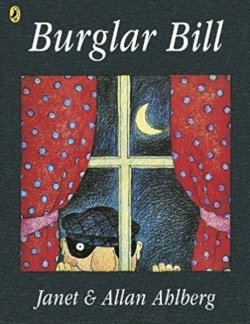Gareth B. Matthews

Review of Burglar Bill by Janet and Allan Ahlberg (London: Mammoth, 1989). Originally published in Thinking: The Journal of Philosophy for Children 12(2): 1.
Burglar Bill lives alone with a house full of stolen property. Every night after supper he goes off to work, stealing things. Every dawn he comes home with his sack full of stolen goods and sits down to his breakfast of stolen toast and marmalade, and stolen coffee. Then he goes upstairs to go to sleep in his stolen bed.
One night, as he makes his usual round of break-ins, Burglar Bill sees a big brown box on the front step of a house he is about to burgle. Since his sack is already full of stolen things and it is almost dawn, he puts the box under one arm, swings his sack of stolen goods over his shoulder, and goes home for breakfast.
After Burglar Bill has had his stolen breakfast, something in the brown box begins to make a loud noise. Burglar Bill opens the box and discovers a baby inside. Thinking that he has picked up an abandoned child, Burglar Bill immediately begins tending to the needs of his new baby. Surprisingly, Burglar Bill shows himself to be a devoted and caring father.
All goes well until, having come home early one night to put his child to bed, Bill hears someone trying to burgle his own house. Putting on the light, he exposes the thief, who turns out to be a woman Bill recognizes from the Police Gazette as Burglar Betty. Bill introduces himself to Betty and the two burglars sit down to a snack of cocoa and ginger cookies.
Betty spots the baby clothing around Bill’s house and soon Bill tells her about finding the abandoned baby. As it turns out, it was Betty herself who had left the baby on the doorstep of a house she was in the process of burgling. Soon Betty is happily reunited with her baby and she and Bill are making plans to get married. Before they get married, however, they return all their stolen goods, one item at a time, and then they resolve to live an honest life together.
Some of my favorite children’s stories are written in a style I call “philosophical whimsy.” Arnold Lobel is a master of this style. When, for example, he has Frog and Toad run from their terrifying experiences into Toad’s house, he has Toad say, as he jumps into his bed and pulls the covers over his head, “Frog, I’m glad to have a brave friend like you.” Frog returns the compliment as he jumps into the closet and shuts the door. Toad stays under the covers and Frog stays in the closet for a long time, “just feeling very brave together.”
Lobel’s whimsical characterization of that last scene in the story, “Dragons and Giants,” heightens our interest in the question that runs through the whole story: “What is bravery?” It focuses special attention on the issue of whether one needs to be frightened to be brave and, at the same time, whether expressions of fear, such as hiding under the covers or in the closet cancel the claim to bravery. As we readers laugh at the thought of Frog and Toad in those circumstances “just feeling very brave together,” we are moved to think about the complex role fear plays in being brave.
Whimsy is also important to the story of Burglar Bill. But this time the whimsy is not directed at the under standing of a difficult concept, such as bravery. This time the whimsy is aimed at encouraging us to think about the life of a full-time thief as if it were an almost boringly normal sort of middle class life.
Of course, it is the baby in the story who leads Burglar Bill and Burglar Betty back to a really normal life. So, here is a story about the redemptive possibilities of family life and traditional values. But the story is also an exercise in empathy and moral imagination. So long as Burglar Bill can avoid all thought of what it must be like to be burgled, he can pursue his anti-social occupation with surprising equanimity. But when Burglar Betty tries to burgle him, he sees his profession in a different light. Moreover, once the possibilities of living a life in a family setting of love and care present themselves, he is moved to return the goods he has stolen and steal no more.
The whimsical “normalization” of the life of a burglar invites us to see thieves as wayward human beings, rather than as monsters or madmen. What they do is certainly wrong, but not beyond the possibilities of redemption and reform. This message may strike some readers as sentimental. On the other hand, the demonization of criminality so common in our society keeps us from recognizing the humanity we share with thieves and helps us to ignore or disguise some of the darker motivations we might other wise find within ourselves as well.
